Archive for the ‘Skydeck’ tag
ShoppinPal.com smart phone app from Fermyon, Inc. improves the brick and mortar retail shopping experience for both buyers and sellers
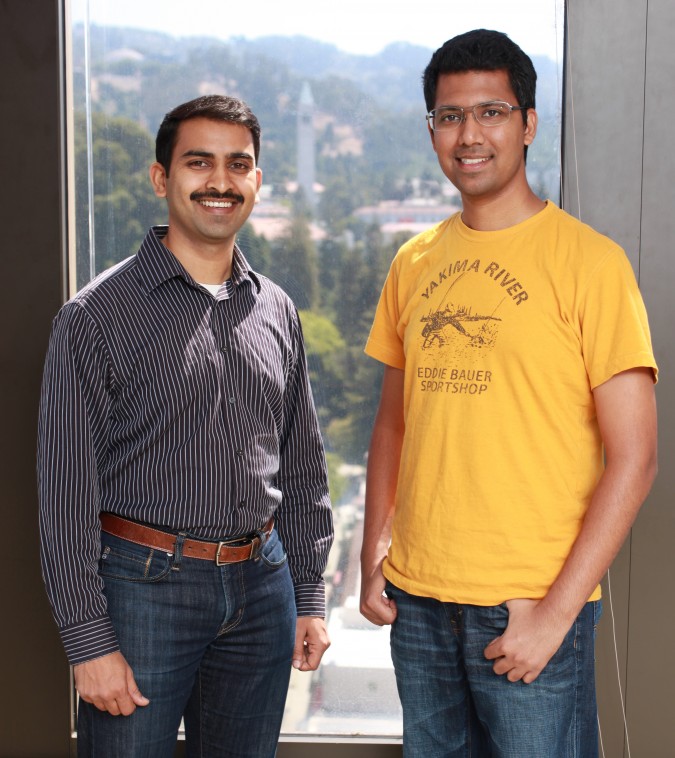
Cofounders of ShoppinPal.com - Sriram Subramanian, CEO, and Pulkit Singhal, CTO. July 26, 2013. Photograph taken at University of California Berkeley Skydeck accelerator, on the top floor of the tallest building in Berkeley, California. That clock tower in the background is on the UC Berkeley campus. Photo by Kevin Warnock.
Fermyon, Inc. is the company behind the impressive ShoppinPal smart phone application that improves the retail brick and mortar retail shopping experience for both buyers and sellers.
On Friday, July 26, 2013, I met with Sriram Subramanian, Chief Executive Officer, 34, and Pulkit Singhal, Chief Technical Officer, 29, the co-founders of Fermyon.
Retailers complain about people treating their physical stores as free showrooms for consumers to touch and evaluate items they will then actually buy online, frequently from giant Amazon. The retailer I suspect feels cheated by these people since they received something valuable, but didn’t make a purchase from the store to compensate the store for their efforts.
Consumers like mobile shopping apps like the one Amazon gives its customers. Smart phone shopping apps let people look up specifications and customer reviews to help them make smarter purchasing decisions. I don’t see shopping apps disappearing, since they offer such compelling value to consumers.
Retailers with physical stores could of course create their own smart phone applications that mimic those from huge online merchants, but it’s mostly larger chain stores that do, because writing a shopping application is difficult and costly.
That’s where ShoppinPal comes in.
ShoppinPal is a service that retailers pay money for — 3% of sales for retailers with over USD $5,000 in monthly ShoppinPal sales, or $49.00 + 3% of sales for retailers that sell less than $5,000 a month through ShoppinPal. This strikes me as assertive pricing, but if it works, Fermyon will be in a position arguably even better than Visa and Mastercard, because Fermyon is not taking any fraud or refusal to pay risk that I can see. On the other hand, no small retailer could hope to deploy a system like ShoppinPal by developing the system itself, and showrooming is a looming problem that likely is motivating retailers to take defensive action.
Shoppers use the service for free.
The retailer gets access to a custom branded application its customers can install on their own phones. In addition, the retailer gets access to an online management console that shows what customers are buying, among many other statistics. Since buyers provide their email address when they install the smart phone app, the store can easily send them custom messages.
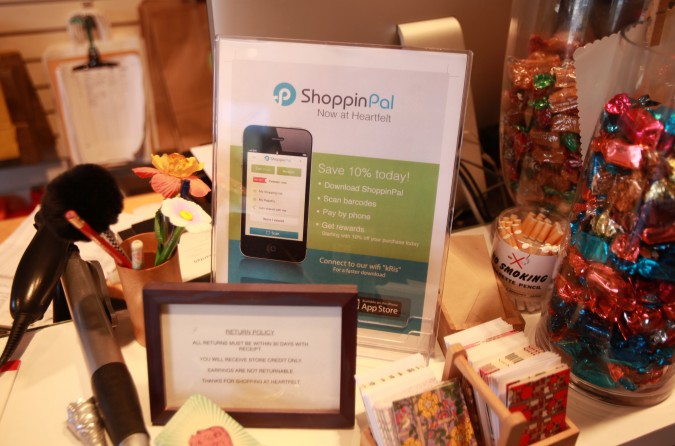
ShoppinPal app display at Heartfelt gift store at 436 Cortland Avenue, San Francisco, California, USA, August 1, 2013. Photo by Kevin Warnock.
For example, if a potential buyer uses the smart phone app to add several items to their ‘wish list’ the store will know about that and can gently remind the potential buyer to return to the store to buy the items. Buyers can be especially enticed to return by being sent discount codes that buyers can use to receive the items at a lower price. Buyers can even opt to have the items delivered to them, offering the convenience of online shopping to the offline world.
I like ShoppinPal. The small team of two co-founders and three staff have put together an offering that appears to come from a larger entity that has raised far more than the modest USD $120,000 in outside capital that Fermyon has taken in.
Buyer engagement potentially starts moments after walking through the door of a shop. One can ‘check in’ to the ShoppinPal app, like one ‘checks in’ on Facebook. The check in alerts store management that the buyer was present.
Next the customer can use the camera on their smart phone to scan the bar code on items they are interested in. The app recognizes the bar code and pulls up that product. The app can, at the option of the retailer, show customers recommendations for other items they may like in their store.
For new retailers, the ShoppinPal cloud based software taps into the retailers’ point of sale cash register system and reviews the receipts for the prior six months of sales. The software sees that people purchased certain items during the same transaction, and uses that set data to recommend that future purchasers also consider such grouped purchases.
CTO Singhal asked current retailers using their system to try the recommendation engine, and those queried marveled at how the recommendations matched with their memory of what many past customers had bought together.
The ShoppinPal app and the website are both beautiful – spare, elegant and clean. The management console is by Mixpanel, a separate company ShoppinPal pays to provide that service.
Sellers can add various incentives for shoppers to buy more items. For example, a discount can be applied after a certain number of purchases. Thus, a coffee shop could automate the ‘buy 10, get 1 free’ paper punch card that still is in use, and was in use at the tea shop where I met with Singhal and Subramanian.
That tea shop in fact allowed customers to store their paper cards in a physical file system on the counter out for the public to access. I marveled the tea shop would put such sensitive information out on public display, because a competitor could surreptitiously copy down a list of the shop’s best and most loyal customers. With quality video cameras in every smart phone, someone could just pretend they were looking for their card while capturing video of every card the thief perused. An electronic loyalty system like that included in ShoppinPal reduces the risk a customer list can fall into the hands of an outsider or an employee that should not have that information.
Inside ShoppinPal, there is not only a wish list, but a gift registry, which should encourage others to buy at a retailer the others may not even be aware of when the items are added to the registry.
ShoppinPal communicates via application programming interfaces to two point of sale cash register systems — Lightspeed Retail and Vend. ShoppinPal hands off to the cash register the precision task of calculating sales tax, sidestepping a thorny problem, since there are thousands of sales tax jurisdictions.
As a customer walks around a store, as they pick up items and place them in their physical shopping cart or basket, they can click ‘add to cart’ within the mobile app. This gives a running total of their planned purchases, and when the customer is ready to pay, they can buy directly from the app, which will display a receipt on screen the customer can show to store staff as they pass through the exit.
This pay within the app feature over time will let retailers hire fewer checkout clerks. The pay within the app feature can be turned off by the retailer that prefers customers visit a cash register to physically run their credit cards through a credit card terminal.
Whether the purchase is paid for in app or at a retailer’s register, the ShoppinPal management console keeps track of all the buyers’ purchases, and makes the purchase history available to the customer, which in my mind is a great perk for the customer. When I shop at Lowes and HomeDepot, I use their loyalty cards mostly because their systems email me a copy of my receipt within minutes after a purchase, which makes my life easier at income tax time.
The sexiest feature of the mobile app is a feature that adds fun to getting a discount. Instead of just writing out ‘you get a discount’ the app presents a silvery gray patch that looks just like the silvery patches covering the digits on lottery tickets. You have to ‘scratch off’ the patch with your finger, and as you rub the screen with your finger, the silvery ‘material’ under your finger vanishes. The effect was startlingly captivating such that I believe a tiny company could be formed just to advance this feature inside other unrelated products from other companies.
ShoppinPal is still an early stage venture. The company was incorporated in January, 2011, but work didn’t really accelerate until CEO Subramanian completed his MBA in June, 2012, last year.
Fermyon has signed up four customers, all via resellers that have agreed to carry their product. I view it as a positive sign that resellers are promoting their product while the company is still so young, for resellers have to be particularly careful to not damage their reputations.
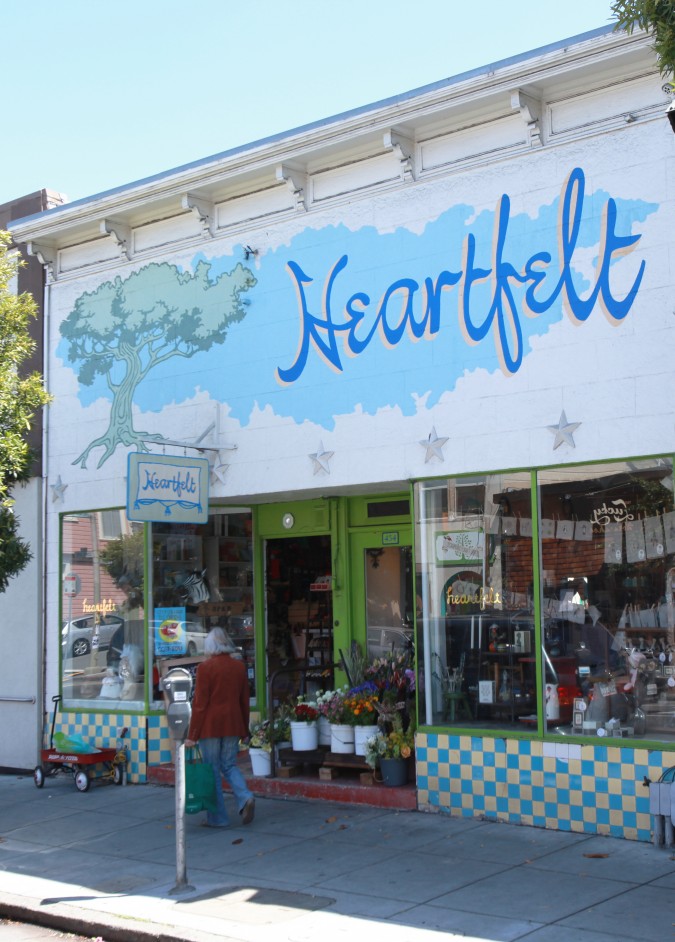
Exterior of Heartfelt gift store at 436 Cortland Avenue, San Francisco, California, USA, August 1, 2013. Photo by Kevin Warnock.
ShoppinPal’s customers are Harney & Sons in New York City, Heartfelt in San Francisco, Isha USA in Tennessee and Marthas Vineyard Glassworks in Massachussets, all in the United States. The Isha implementation is the most demanding, because the organization runs events that draw about 1,000 people twenty times or so per year, so the transaction volumes spike tremendously during events and subside the rest of the year.

Interior of Heartfelt gift store at 436 Cortland Avenue, San Francisco, California, USA, August 1, 2013. Photo by Kevin Warnock.
I live in San Francisco, so I decided to install the ShoppinPal app on my Apple iPhone 5 and visit Fermyon’s customer Heartfelt, a charming and totally adorable gift shop in the Bernal Heights neighborhood. This single store business doesn’t sell items that people are likely to evaluate and then order online from a giant website. But the Heartfelt is the kind of place that I think could benefit from the loyalty, gift registry and wish list features in ShoppinPal. The store also I suspect prides itself on having just the right gift, as there appear to be over 10,000 different items for sale inside this small store. As I was browsing around, I found half a dozen items I wanted to buy, and I am not even looking for gifts right now.

Jewelry for sale at Heartfelt gift store at 436 Cortland Avenue, San Francisco, California, USA, August 1, 2013. Photo by Kevin Warnock.
As soon as you check in, a horizontal red line starts sweeping up and down the phone display. The indicates the phone is looking for a bar code to recognize. I created a video of the ShoppinPal experience from checking in to just before payment. I have embedded the video into this post. The video is a bit shaky because I had to hold my large camera in one hand, and operate the app with my other hand, and since the phone was so close, the depth of field was shallow. But the video does show faithfully what the app does.
As soon as the app finds a bar code, it goes into search mode where it’s communicating with the cash register computer to find the item. This takes about two to six seconds. Then the item shows up in your shopping cart. From there it is confusing what to do next, since there is no ‘checkout’ or ‘buy now’ button. Instead, to continue shopping, you are to press the button in the upper left labeled ‘heartfelt,’ the name of the store. This should be labeled ‘back’ or ‘continue shopping.’ There is a button in the upper right called ‘cart.’ I didn’t try that button, but I assume that button takes you to the shopping cart from where one can checkout.
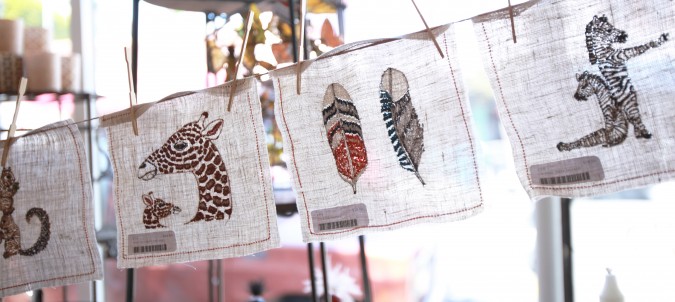
Textiles for sale at Heartfelt gift store at 436 Cortland Avenue, San Francisco, California, USA, August 1, 2013. Photo by Kevin Warnock.
I scratched off the panel as invited, and I got a 10% discount. I was given the chance to pay via credit card or PayPal, the payment service from auction giant EBay. I bought a lightweight wallet made from Tyvek, and I paid via PayPal. The process was quick and efficient, but my receipt listed my discount as $0.00 even though the 10% discount had been correctly applied to the total. I understand that ShoppinPal was only recently installed at Heartfelt, so I expect there to be small glitches to be worked out. For such an early stage yet ambitious application, ShoppinPal performed well.
As you might imagine, ShoppinPal has big dreams and has had sales meetings with huge brands that are household names throughout the US. I suspect that after they build their credibility with smaller retailers for the following months that they will land a national retailer.
ShoppinPal participated in 2012 in the Silicon Valley Bank Seed Showcase, a pitch event to investors for Silicon Valley Bank clients. Silicon Valley Bank is widely considered one of the most important banks in Silicon Valley for startups that aspire to or have raised venture capital investment. You can watch CEO Subramanian pitch on stage and then watch him later that day be interviewed by Carrie Walsh, Managing Director II, ESG, Silicon Valley Bank.
I could find no direct competitors to Fermyon.
The closest offering appears to be CardFree, which automates via a smart phone app some of the tasks that ShoppinPal automates, like payment and loyalty. But CardFree omits the ability to scan the barcode of products to bring up specifications and Amazon.com like product recommendations, two of the most compelling features of ShoppinPal, in my mind.
Another company that does part of what ShoppinPal does is CardStar from Constant Contact. CardStar appears to be a smart phone app just for storing and using loyalty cards from multiple retailers, so your physical wallet doesn’t burst from storing too many physical cards, like mine is threatening to do.
Another loyalty card company is BellyCard, which appears to be similar to CardStar.
Finally, there is a smart phone payment app called AisleBuyer, which lets in store purchasers pay via their smart phone. This company was acquired by Intuit in 2012.
See what former CNET Editor at Large Rafe Neeleman had to say about ShoppinPal in 2012.
The company’s name Fermyon is a play on the particle physics term Fermion. The definition of the Fermion is better left to the article on Wikipedia I just referenced.
I took the picture of Subramanian and Singhal that accompanies this post with my Canon 5D Mark II camera, my Canon 50mm f:2.5 macro lens and my Paul C. Buff Einstein studio flash unit.
The location of the photograph is the Skydeck accelerator run by University of California Berkeley. Jeff Burton is the Executive Director of Skydeck, and Burton encourages me to write about the UC Berkeley affiliated companies that the accelerator houses in its exceptionally glorious 10,000+ square feet of penthouse office space. If you look out the window in the center of the picture, you will see the clock tower that serves as the focal point of the UC Berkeley campus. ShoppinPal is headquartered at Skydeck, but this is not an indicator that the team is reckless with its finances. To the contrary, it’s an indicator that the team is careful with its money since the company’s office space is provided for free by the University of California, from where Subramanian earned his Masters of Business Administration graduate degree. Skydeck gives free office space to only the companies it deems most likely to succeed.
I became aware of Subramanian over the last year because we both attend monthly Cal Founders meetings, which are designed to help founders and mentors be more successful in business. Subramanian and I are more acquaintances than friends since we’ve only met and spoken a handful of times. He learned of this blog and asked if I would write about his venture, and I agreed because I had become intrigued when he had introduced his company during the roundtable discussions at Cal Founders meetings. I disclose the circumstances of how we met to deflect any appearance of bias due to my already knowing Subramanian.
I meet the Picatcha.com team at the University of California Berkeley Skydeck startup accelerator
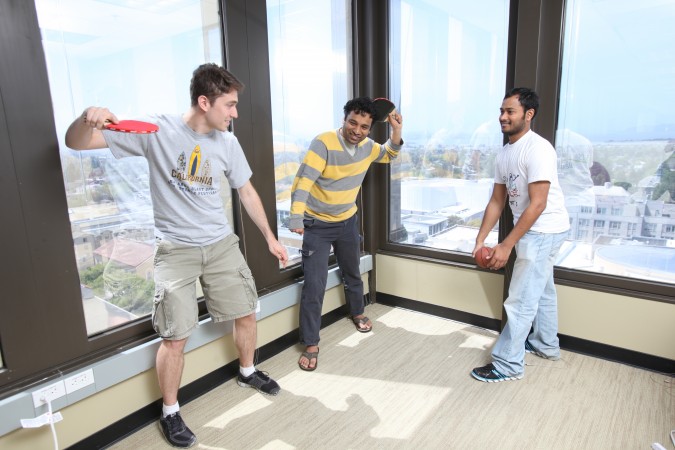
Picatcha.com team playing ping pong with a basketball. May 2, 2012, at University of California Berkeley Skydeck startup accelerator. Photograph by Kevin Warnock.
On May 2, 2012 I met with Satish Polisetti, Dhawal Mujumdar and Sean Carey of Picatcha.
Picatcha is a made up word combining ‘picture’ and ‘Captcha.’
Captcha stands for Computer Automated Public Turing Test to tell Computers and Humans Apart. Captchas were invented by researchers at Carnegie Mellon University.
Even if you don’t recognize the word captcha, you know the test. Here’s an example of Captcha used by Facebook [where I encourage you to subscribe to my posts]:
This Captcha was posted to the photo sharing site Flickr because the first word is difficult to read. You can see Flickr user Chance Abbatoir couldn’t make out the word and wrote wtf? in its place. Wtf is short for ‘what the fuck’ for my readers who aren’t familiar with this slang term.
This illustrates the problem Picatcha is trying to solve.
Regular Captchas similar to the example from Facebook here are too easy for computers to figure out. That allows bad guys to do things they should not do, like buy hot concert tickets as soon as they go on sale, bumping out actual people by overwhelming the websites where the tickets are sold, such as at TicketMaster and Live Nation. The ticket sites assume the buyers are legitimate because the Captchas are correctly deciphered. As a result, more concert goers have to buy their tickets at inflated prices on the secondary market.
In response to such fraud against web properties, traditional Captchas are getting more difficult for humans to solve, such as the one shown here from Facebook. I suspect it says ‘N 1/4’ but I can’t be certain. Can you?
Computers and software are improving. There’s an arms race between conventional Captcha writers and the bad guys. The bad guys are winning.
Picatcha has a different approach.
Picatcha presents a challenge that’s currently difficult for a computer to solve.
The Picatcha twist is that users are asked to look at a set of images and identify the subset that matches a word. For example:
In this example the user has to click on the two middle pictures on the top row, and the second and last picture on the second row. Teaching a computer how to solve this puzzle is much harder than training optical character recognition software to decipher regular Captchas, according to Picatcha. Think about it from the computer’s perspective… the Picatcha way requires machine vision to identify arbitrary objects. OCR only has to deal with 26 letters and 10 digits. A computer trained to break Picatchas would have to handle a vast array of images, which could be crude line drawings up to detailed color photographs.
Picatcha does a lot of other things that make it more compelling than what I’ve so far described.
They allow customers to use images of their products in their picture captchas. Imagine how this would thrill consumer product companies. Imagine how personal this makes the test for users. Suddenly the access tests can become fun, not irritating.
You solve Picatchas by clicking or touching, not typing, making them much more friendly to solve from smart phones and tablets.
There’s extra tricky security happening under the covers, I was told, so this is not a quick programming project to duplicate.
Even more compelling is the Picatcha system can vary the images depending on who the user is. That’s right, the system can tap into your location and demographic data that Picatcha has access to via commercial ad serving services. This strikes me as a brilliant way to enhance user satisfaction and make it more likely they’ll sign up for or buy whatever is behind the Picatcha.
I am impressed with Picatcha. So were the semi-final round judges for the 2011 University of California Berkeley Business Plan Competition, hosted by The Lester Center for Entrepreneurship & Innovation and led by Executive Director André Marquis. Picatcha competed in that competition in 2011 and advanced to the elite final group of eight teams [Note to the Berkeley Business Plan Competition organizers: Keep these links valid in perpetuity. Right now it appears only two years of winners are identified at your site. All winners and finalists back to the 1999 inception of the competition should be listed. Thank you.]. Picatcha collected a cash prize for their efforts. It’s very, very difficult to advance to the finals in that competition… I know as I was a semi-final round judge in that competition. I was not a judge for Picatcha, as I served on the Products & Services track, and Picatcha competed on the Information Technology & Web track. I did not meet the Picatcha team last year at the finals, as I was not yet a tech blogger.
Picatcha started as a school project for Co-Founders Mujumdar and Polisetti when they were students at the School of Information at University of California, Berkeley. They described their work in an attractive summary report. Their Advisor was Bob Glushko.
Picatcha is a hosted service, so its customers don’t need to install any software on their web servers. According to the front page of the Picatcha website today, the company has served up over four million access tests so far, on over 200 customer websites.
When I was meeting with Co-Founder Dhawal Mujumdar last week, he showed me the Picatcha implementation for a brand so famous you are all but certain to have heard of it if you live where their product is sold — M & Ms, the chocolate candy from Mars that melts in your mouth, not on your hands.
Picatcha is sharing office space with other impressive startups at Skydeck, the startup accelerator at University of California at Berkeley, in Berkeley, California USA. I met the Picatcha team after I informed Eliot Sun from Kloudless, Inc. that I’d like him to introduce me to another team, as I had time before my next meeting, and I wanted to be productive. I’ve wrote about Kloudless yesterday, May 7, 2012. I took the pictures for this post. Click on them to see them at full 21 megapixel resolution. There are many more good shots of the Picatcha team playing basketball ping pong in a public album on my Facebook page.






